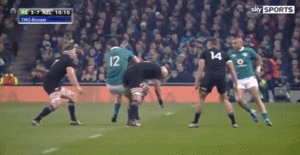If you are a player heading into a citing, whenever you think you are guilty, innocent or somewhere in that lovely, grey middle, there are a couple of moves that will help your case.
- Dress presentably.
- Express remorse for the injured party.
- Get in contact with the injured party or at least make an effort to.
Citings and the reviews that follow are old hat at this stage. It is a well-worn system and, like any system, folks have figured out how to make it work best on their behalf.
No matter how bad the blood – see Pascal Papé kneeing Jamie Heaslip in the back in 2015 – the cited player will reach out to check on the man that took the hit. Papé had no joy getting Heaslip’s phone number so apologised via Twitter. The Ireland No.8, who had fractured three vertebrae in the incident, responded:
‘Thanks for your message. Rugby is a physical game and one accepts that can happen. I accept your apology completely.’
The apology is not reserved to players that level Irishmen. In October, Keith Earls dump-tackled Glasgow’s Fraser Brown and was shown a red card. There was some pushing and shoving as a fired-up Earls left the field of play but Earls still rang Brown in the days after the incident.
Earls may have called Brown to clear the air but the conversation did not exactly go smoothly. Earls explained:
“The way he went, I thought he was going for it [the red card] a small bit, to be honest with you. I spoke to him and he said he was just trying to protect himself.”
Earls was remorseful in front of the disciplinary panel at least and he had reached out to Brown. He got a two-week ban and was later forced to apologise for not fully owning and accepting his actions.
Last November, Sam Cane went in hard on Robbie Henshaw. His intentions were clearly to make a big hit but the fact that Henshaw spun just before impact meant a side-on thump ended up being an awful case of shoulder on head.

Henshaw was concussed from the incident and did not return after he was stretchered off. Cane escaped yellow- or red-card sanction on the pitch but limped off 10 minutes later after being forcibly cleaned out of a ruck.
Cane was one of two New Zealand stars cited after their victory over Ireland but only Malakai Fekitoa – for a swinging arm hit on Simon Zebo – was banned. The flanker was cleared of any wrongdoing.
On Tuesday, Cane spoke with journalists about the Henshaw hit. Bizarrely, he brought up one camera angle that ‘looked definitely it was head on head’ when multiple angles showed his shoulder crunching into Henshaw’s head.
Cane reached out to Henshaw. Of course he did. He said:
“I managed to get his phone number the next day and flick him a text.
“I did keep an eye to see how long he was out for so it’s good to see him back playing.”
Some may argue that Cane’s text was following the worn track of contacting the player on the receiving end simply to appear empathetic and considerate of fellow pros. Others would contest that there was genuine regret that his hit caused so much damage to Henshaw. The truth may be somewhere in between.
We may never know but everything we know about Cane is that he is a stand-up lad.
For now, we’ll leave it to him to reflect on a collision that caused ripples for days that bled into weeks.
“We’re not super human and we can’t change direction in the blink of an eye,” he mused. “To have avoided that collision I would have had to have fallen through a trap door.”





































